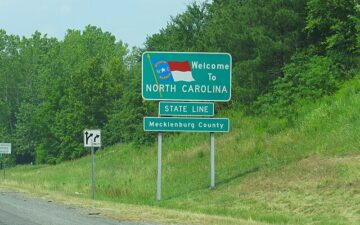North Carolina: Census 2020 Real-Time Response Rates – Week ending April 12 (.pdf)
View All County-Level Response Rates –
Week ending April 12
Key takeaways for week ending April 12
- Less than half of NC households have completed the 2020 Census. 44.9% of NC households had self-responded to the Census as of April 12, below the national average of 47.9%. In Minnesota, the top-performing state, 57.2% of households have responded to the census.
- Self-response rate steadily increasing, but rate of growth slowing. From April 5th to April 12th, self-response only grew 3.2 percentage points from 41.7% of households to 44.9% of households. From Week 1 to Week 2, cumulative self-response grew by 16.4 percentage points, and from Week 2 to Week 3, self-response grew by 8.7 percentage points.
- North Carolina’s rank continues to slowly rise. As of April 12th, North Carolina is now ranked 36 out of 50 states and DC – one rank higher than the previous week.
- Seven southeastern states outrank North Carolina in self-response. These are Virginia (53.5%), Kentucky (49.5%), Tennessee (48.0%), Alabama (47.2%), Mississippi (46.4%), Florida (46.1%), and Georgia (45.3%).
- For the third week in a row, Orange, Union, Wake and Chatham counties are among the top five highest-responding counties. Davie County was also in this week’s top five. All counties are located in either the Triangle, Charlotte, or Triad metropolitan area and all of them have response rates of 50% or more.
- Suspension of Census Bureau field operations continues to impact lowest-responding counties. Graham, Avery, Jackson, Dare, and Swain counties remain the five lowest-responding counties. As we reported last week, these counties had a high proportion of “Update/Leave” households that were expected to receive a paper questionnaire during this phase of operations. As field operations remain suspended due to COVID-19, many of these households have not yet been invited to participate.
- Response rates lowest in census tracts with the smallest share of young children. As of April 12, an average of 42.9% of households responded to the Census in tracts where less than 4.1% of residents are young children – 2 percentage points lower than the state. As we reported last week, this may be related to displacement in college towns due to COVID-19.
- Tracts with highest immigrant populations continue to have the highest average response rates. An average of 46.6% of households responded to the Census in tracts where 9.8% or more of the population is foreign-born. This is followed by tracts with 5.7% to 9.8% foreign-born residents (46.3%). Tracts with few immigrants (<2.9% of residents) had the lowest average response rate (41.3%).
- Gap between state response rate and average response rate for high minority tracts (>50% residents) continues to widen. As of April 12, households in high minority tracts (>50% residents) had an average response rate of 40.1%. This was 4.8 percentage points below the state. This gap has grown from week ending April 5th (-4.3 percentage points) and week ending March 31st (-3.3 percentage points).
- Tracts with highest internet access had a substantially higher rate of average response than tracts with lowest access. High internet access tracts had an average response rate of 52.8%, while tracts with the lowest rates of internet access had an average response rate of 38.9%. This represents a gap of 13.9 percentage points.
Last updated: 4.14.20


